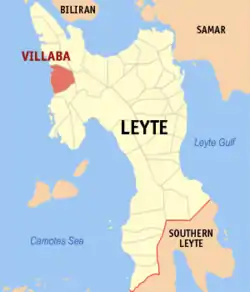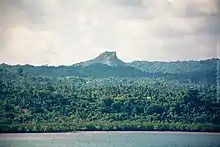Villaba
Villaba (IPA: [vɪ'ʎabɐ]), officially the Municipality of Villaba (Cebuano: Lungsod sa Villaba; Waray: Bungto han Villaba; Tagalog: Bayan ng Villaba), is a 3rd class municipality in the province of Leyte, Philippines. According to the 2020 census, it has a population of 42,859 people.[3]
Villaba | |
|---|---|
| Municipality of Villaba | |
 The Mt. Buga-buga viewed from barangay Abijao, Villaba | |
 Flag | |
 Map of Leyte with Villaba highlighted | |
OpenStreetMap | |
.svg.png.webp) Villaba Location within the Philippines | |
| Coordinates: 11°13′N 124°24′E | |
| Country | Philippines |
| Region | Eastern Visayas |
| Province | Leyte |
| District | 3rd district |
| Barangays | 35 (see Barangays) |
| Government | |
| • Type | Sangguniang Bayan |
| • Mayor | Carlos G. Veloso |
| • Vice Mayor | Dennis L. Sy |
| • Representative | Vicente Sofronio E. Veloso III |
| • Councilors | List |
| • Electorate | 31,346 voters (2022) |
| Area | |
| • Total | 150.31 km2 (58.04 sq mi) |
| Elevation | 29 m (95 ft) |
| Highest elevation | 442 m (1,450 ft) |
| Lowest elevation | 0 m (0 ft) |
| Population (2020 census)[3] | |
| • Total | 42,859 |
| • Density | 290/km2 (740/sq mi) |
| • Households | 11,022 |
| Economy | |
| • Income class | 3rd municipal income class |
| • Poverty incidence | 26.25 |
| • Revenue | ₱ 188.1 million (2020) |
| • Assets | ₱ 351.2 million (2020) |
| • Expenditure | ₱ 300.1 million (2020) |
| • Liabilities | ₱ 74.82 million (2020) |
| Service provider | |
| • Electricity | Leyte 5 Electric Cooperative (LEYECO 5) |
| Time zone | UTC+8 (PST) |
| ZIP code | 6537 |
| PSGC | |
| IDD : area code | +63 (0)53 |
| Native languages | Cebuano |
History
Pre-Spanish History
The existence of the place now known as Villaba was discovered in about the last quarter of the sixteenth century by Boholano traders. These traders landed on the western coast and found fertile plains along the river and forest. The sea coast also proved to be good fishing ground. The settlers built their houses along the banks of the river and banded into groups to protect themselves from the moro pirates and wild animals. Along the banks of the river were "Hindang" trees which grew in abundance so they called the new settlement Hamindangon (full of hindang trees).
As the years passed, more settlers migrated from Bohol and Cebu. These new inhabitants likewise settled on the plains along the Hamindangon River.
Spanish Period
During the expedition of the entire Eastern Visayas by Spanish conquistador in 1593, a group of Spaniards, led by the General-Governor's son, Luis Pérez Dasmariñas landed on the shores of Hamindangon and the named the place Nueva Galicia in honor of his father, the Governor-General of the Philippines, Gomez Perez Dasmariñas who is from Galicia, Spain.
The governor set sail from Cavite for Pintado province in October 1593, to join the part of the fleet under Luis Pérez who is already at the Visayas. Before he proceeded to Moluccas, Luis Pérez introduced the barrio of Nueva Galicia to the whole fleet. But the Governor-General renamed the place to Vilalba (from the Spanish town in Galicia region) in order not to confused with other Nueva Galicia town that is located in Mexico.
Over the years, the natives of the barrio had problem of Spanish unaccented digraphs, mispronouncing Vilalba (Spanish pronunciation: [biˈʎalβa]) with Villaba (IPA: [vɪ'ʎabɐ]), and perhaps, it is easier to pronounce the later name and thus retained it when the town was officially established in June 1910.[5]
American Period
The Spanish was defeated by the Americans who started their occupation of the Philippines on August 13, 1898. The following year, there was a popular revolt in the Visayas particularly in Samar and Leyte called the Pulahanes movement. One consequence of that revolution against the Americans was that the town of Villaba was reduced to a barrio and became part of the municipality of San Isidro, Leyte.
During that period, Villaba was then ran by local executives known as cabeza de barangay. For want of official records however, to provide a complete list and their specific terms of office, the following have served in the said capacity:
1. Andres Gervacio
2. Antonio Dejillo
3. Fortunato Cabilar
4. Hermogenes Tumamak
5. Casimiro Tumamak
7. Tomas Tumamak
8. Luciano Domael
In June 1910, the Provincial Board of Leyte passed and approved a resolution creating the Municipality of Villaba. Since then, there was a continuous change of Chief Executives in the municipality up to the present.
1. Juan Burgos - 1910 to 1912
2. Flaviano Domael - 1913 to 1915
3. Carmelino Rubillos - 1916 to 1918
4. Flaviano Domael - 1919 to 1921
5. Paulino Dejillo - 1922 to 1924
6. Flaviano Domael - 1925 to 1927
7. Damian Perez - 1928 to 1930
8. Bartolome Esmas - 1931 to 1939
9. Vicente Veloso - 1940 to 1945
10. Eusebio Gaviola - 1945 to 1946
11. Fermin Tumamak - 1946 to 1950
12. Francisco Burgos - 1951 to 1959
13. Alberto Veloso - 1960 to 1963
14. Bartolome Esmas - Oct 1963 to Dec 1963
15. Sofronio Ramirez - 1964 to 1967
16. Aurelio Veloso - 1968 to Apr 1980
17. Antonio Villamor - May 1980 to Apr 20,1986
18. Faustino Tumamak - (OIC) Apr 21, 1986
19. Roman Omega - (OIC) Dec 4, 1987 - Feb 1988
20. Faustino Tumamak, Jr. - Feb 1988 to Mar 1992
21. Leonora Rosal - Mar 1992 to Jun 1992
22. Jorge V. Veloso - Jul 1,1992 to 1998
23. Atty. Faustino Tumamak Jr.- 1998 to 2004
24. Claudio Martin Larrazabal - 2004 to 2013
25. Jorge V. Veloso - 2013 to 2016
26. Juliet A. Larrazabal - 2016 to 2019
27. Jorge V. Veloso - 2019 to June 2022
28. Carlos G. Veloso - July 2022 to present
Barangays

Villaba is politically subdivided into 35 barangays. [6] Each barangay consists of puroks and some have sitios.
- Abijao
- Balite
- Bugabuga
- Cabungahan
- Cabunga-an
- Cagnocot
- Cahigan
- Calbugos
- Camporog
- Capinyahan
- Casili-on
- Catagbacan
- Fatima (Poblacion)
- Hibulangan
- Hinabuyan
- Iligay
- Jalas
- Jordan
- Libagong
- New Balanac
- Payao
- Poblacion Norte
- Poblacion Sur
- Sambulawan
- San Francisco
- Silad
- Sulpa
- Tabunok
- Tagbubunga
- Tinghub
- Bangkal
- Canquiason
- San Vicente
- Santa Cruz
- Suba
Climate
| Climate data for Villaba, Leyte | |||||||||||||
|---|---|---|---|---|---|---|---|---|---|---|---|---|---|
| Month | Jan | Feb | Mar | Apr | May | Jun | Jul | Aug | Sep | Oct | Nov | Dec | Year |
| Average high °C (°F) | 28 (82) |
29 (84) |
29 (84) |
31 (88) |
31 (88) |
30 (86) |
30 (86) |
30 (86) |
30 (86) |
29 (84) |
29 (84) |
29 (84) |
30 (85) |
| Average low °C (°F) | 22 (72) |
22 (72) |
22 (72) |
23 (73) |
24 (75) |
25 (77) |
25 (77) |
25 (77) |
25 (77) |
24 (75) |
24 (75) |
23 (73) |
24 (75) |
| Average precipitation mm (inches) | 73 (2.9) |
56 (2.2) |
75 (3.0) |
71 (2.8) |
114 (4.5) |
174 (6.9) |
172 (6.8) |
163 (6.4) |
167 (6.6) |
161 (6.3) |
158 (6.2) |
125 (4.9) |
1,509 (59.5) |
| Average rainy days | 15.2 | 12.5 | 16.2 | 17.3 | 23.9 | 27.3 | 28.4 | 26.9 | 26.9 | 27.1 | 23.8 | 19.3 | 264.8 |
| Source: Meteoblue[7] | |||||||||||||
Demographics
|
| |||||||||||||||||||||||||||||||||||||||||||||||||||
| Source: Philippine Statistics Authority [8][9][10][11] | ||||||||||||||||||||||||||||||||||||||||||||||||||||
In the 2020 census, the population of Villaba was 42,859 people,[3] with a density of 290 inhabitants per square kilometre or 750 inhabitants per square mile.
Economy
References
- Municipality of Villaba | (DILG)
- "2015 Census of Population, Report No. 3 – Population, Land Area, and Population Density" (PDF). Philippine Statistics Authority. Quezon City, Philippines. August 2016. ISSN 0117-1453. Archived (PDF) from the original on May 25, 2021. Retrieved July 16, 2021.
- Census of Population (2020). "Region VIII (Eastern Visayas)". Total Population by Province, City, Municipality and Barangay. Philippine Statistics Authority. Retrieved 8 July 2021.
- "PSA Releases the 2018 Municipal and City Level Poverty Estimates". Philippine Statistics Authority. 15 December 2021. Retrieved 22 January 2022.
- "Philippine Places of Spanish Origin". Tourism In The Philippines. Retrieved November 13, 2018.
- "Province:". PSGC Interactive. Quezon City, Philippines: Philippine Statistics Authority. Retrieved 12 November 2016.
- "Villaba: Average Temperatures and Rainfall". Meteoblue. Retrieved 29 February 2020.
- Census of Population (2015). "Region VIII (Eastern Visayas)". Total Population by Province, City, Municipality and Barangay. Philippine Statistics Authority. Retrieved 20 June 2016.
- Census of Population and Housing (2010). "Region VIII (Eastern Visayas)" (PDF). Total Population by Province, City, Municipality and Barangay. National Statistics Office. Retrieved 29 June 2016.
- Censuses of Population (1903–2007). "Region VIII (Eastern Visayas)". Table 1. Population Enumerated in Various Censuses by Province/Highly Urbanized City: 1903 to 2007. National Statistics Office.
- "Province of". Municipality Population Data. Local Water Utilities Administration Research Division. Retrieved 17 December 2016.
- "Poverty incidence (PI):". Philippine Statistics Authority. Retrieved December 28, 2020.
- "Estimation of Local Poverty in the Philippines" (PDF). Philippine Statistics Authority. 29 November 2005.
- "2003 City and Municipal Level Poverty Estimates" (PDF). Philippine Statistics Authority. 23 March 2009.
- "City and Municipal Level Poverty Estimates; 2006 and 2009" (PDF). Philippine Statistics Authority. 3 August 2012.
- "2012 Municipal and City Level Poverty Estimates" (PDF). Philippine Statistics Authority. 31 May 2016.
- "Municipal and City Level Small Area Poverty Estimates; 2009, 2012 and 2015". Philippine Statistics Authority. 10 July 2019.
- "PSA Releases the 2018 Municipal and City Level Poverty Estimates". Philippine Statistics Authority. 15 December 2021. Retrieved 22 January 2022.